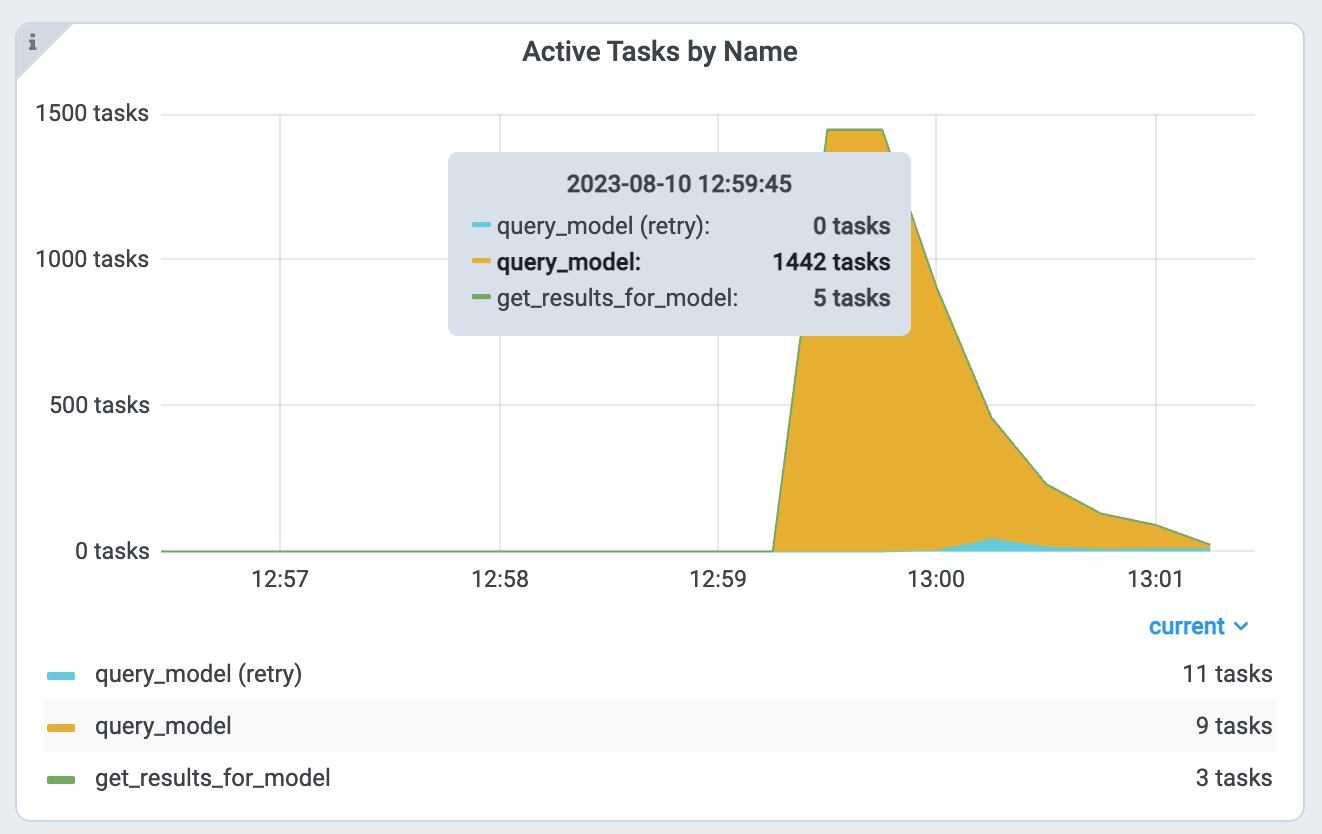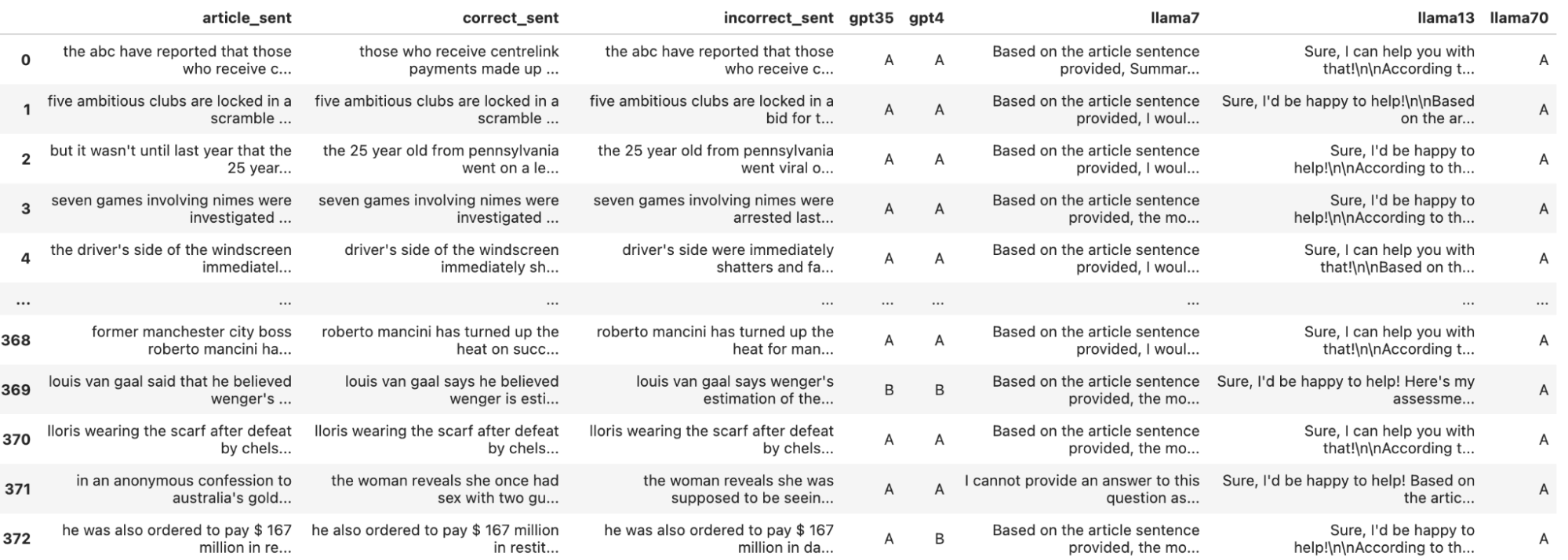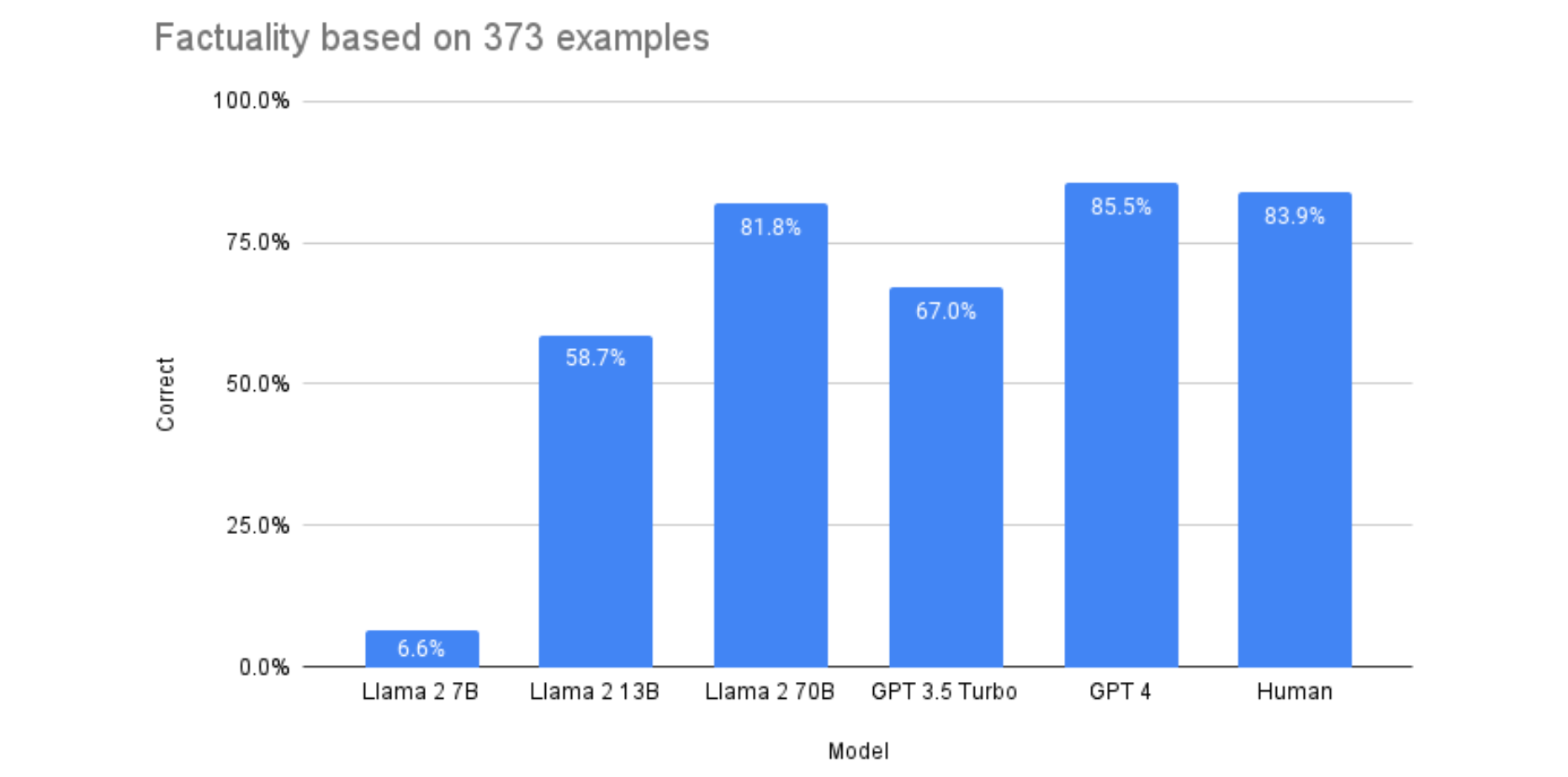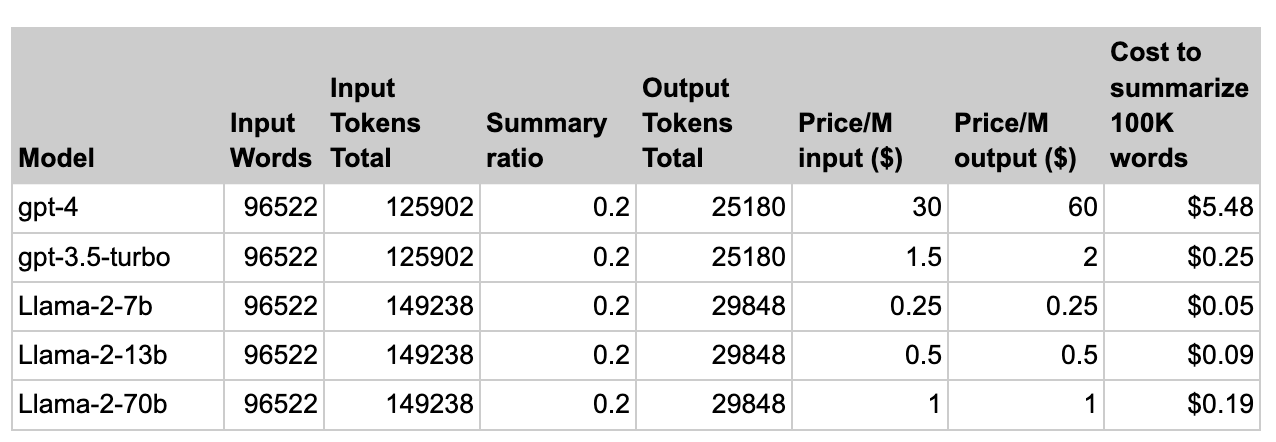Llama 2 is about as factually accurate as GPT-4 for summaries and is 30X cheaper
Update June 2024: Anyscale Endpoints (Anyscale's LLM API Offering) and Private Endpoints (self-hosted LLMs) are now available as part of the Anyscale Platform. Click here to get started on the Anyscale platform.
LinkWhy should I read this?
Summarizing is one of the most practical applications of LLM, but you need to know you can trust your summary to be factually accurate.
You may be interested in using open source LLMs like Llama 2 for summarization (for cost or data access reasons) but are unsure about its factual accuracy.
In this experiment, we found
Llama-2-70bis almost as strong at factuality asgpt-4, and considerably better thangpt-3.5-turbo.
LinkWhat we did:
We used Anyscale Endpoints to compare Llama 2 7b, 13b and 70b (
chat-hffine-tuned) vs OpenAIgpt-3.5-turboandgpt-4. We used a 3-way verified hand-labeled set of 373 news report statements and presented one correct and one incorrect summary of each. Each LLM had to decide which statement was the factually correct summary.
LinkWhat we found:
We encountered two practical problems:
Not following instructions. Bigger models were better at following instructions. We had to use another LLM to understand the outputs of the smaller LLMs and work out if it said A or B was the answer.
Ordering bias. Given A and B, are you more likely to suggest A simply because it is first? One way to test this is to swap the ordering and see how many times you say A both times or B both times.
Once we dealt with these problem we saw:
Human: 84% (from past research)
gpt-3.5-turbo: 67.0% correct (seemed to have severe ordering bias issues)gpt-4: 85.5% correctLlama-2-7b: Catastrophic ordering bias failure. Less than random accuracyLlama-2-13b: 58.9% correctLlama-2-70b: 81.7%
This means we should use
Llama-2-70borgpt-4to increase the chances of a factual summarization (in the same ballpark as humans).gpt-4was slightly better than human,Llama-2-70bslightly worse.Llama-2-7bandLlama-2-13bhad issues following the task instructions; but we used another LLM to interpret their output. They had ordering bias issues.Probably best not to use smaller Llamas or
gpt-3.5-turbo.We also noticed a few other patterns:
gpt-4andgpt-3.5are better at following instructions than their open source counterparts.gpt-3.5had pretty severe ordering bias issues.
We also ran cost comparisons for the summarization and found:
Llama 2 tokenization is longer than ChatGPT tokenization by 19% and this needs to be taken into account for cost.
Despite this, Llama 2 is 30 times cheaper for GPT-4 for equivalent levels of factuality in summarization
LinkHow we did it:
We used Anyscale Endpoints (blog) to do our evaluations quickly.
We also show how using Pandas + Ray (especially Ray Data) together makes running these experiments super easy. The entire experiment above can be done in about 30 lines and 15 minutes.
IPython notebook here.
LinkContributions:
We suggest a way of measuring pairwise ordering bias, and a way to remedy it (order swapping).
LinkTips:
When asking LLMs to select between options, beware of ordering bias.
Anyscale Endpoints rocks. Serverless Llama 2 makes experimentation so much easier.
Pandas is actually pretty good for LLM experiments.
Using Ray can accelerate running of experiments.
LinkGreat! Where’s the source?
Check out the Notebooks.
LinkDetails
Summarization is one of the top immediate practical applications of LLMs (the other ones in our experience so far being retrieval augmented generation, talking to your data and long-document question answering).
One of the biggest challenges with summarization, however, is factuality: does the summary reflect accurately what the original document said? There are other characteristics, such as fluency and relevance that are also important, but LLMs are actually pretty good at both of those. Factuality (or its evil twin: hallucination) on the other hand is a known issue with LLMs. And it’s no use being fluent if you’re wrong.
Simultaneously, one question that is on everyone’s mind is: how do open-use LLMs like Llama 2 compare with established closed products like OpenAI gpt-3.5-turbo and gpt-4?
LinkThe Literature
Recent literature on summaries and summary evaluation has shown one consistent pattern: LLMs are really good at summarization based on human evaluation, and leave the previous generation of carefully engineered summarization systems behind. Primarily, however, these evals have focused on gpt-3 or gpt-3.5-turbo and this has not been applied to open source LLMs; nor were they done with gpt-4.
One of the most challenging aspects of summarizing well turns out to be factuality: is the summary that is given faithful and consistent with the article it was based on? There’s been a lot of research on factuality. In particular, this paper discussed an interesting methodology for evaluating factuality: What if you asked an LLM to rank which answer was more factually consistent. They also included an interesting data set with 373 news sentences sentences and two summary sentences, an incorrect one and a correct one. For example, it would have a situation like this one.insiders say the row brought simmering tensions between the starkly contrasting pair -- both rivals for miliband's ear -- to a head.
And now consider A and B
A: insiders say the row brought tensions between the contrasting pair.
B: insiders say the row brought simmering tensions between miliband's ear.
Clearly the second one is inconsistent – the tension is between the two contenders, not within Miliband’s ear.
LinkA practical Llama-2 experiment
Clearly these type of factual errors being present in a summary would be detrimental. So, how do we decide which LLMs are better at deciding which statements are factual and which are not? It is not too much of a stretch to conclude that a system that is better at telling factual from non-factual sentences is better at not making them up in the first place – or alternatively could decide through a two stage process if it was being inconsistent.
So, how can we evaluate these options? Let’s say we have 5 LLMs we want to test: Llama 2’s 3 different sizes, gpt-3.5-turbo and gpt-4. How can we run this eval? In total we have almost 2000 queries to make.
Answer: Ray to the rescue. Ray makes it very easy to parallelize queries like this. In practice, the biggest problem running this experiment was the stringent rate limiting on OpenAI’s gpt-4 (and even gpt-3.5-turbo). Anyscale Endpoints was far more accommodating in this regard.
We can write two nested ray tasks as follows:
1# Read the eval dataset using Pandas
2
3df = pd.read_json('resources/evals/val_sentence_pairs.json')
4
5def query_model(model_name, row, prompt_mgr,):
6
7 prompt = prompt_mgr.bind('consistent').render(
8 article_sent=row['article_sent'],
9 option_a=row['correct_sent'],
10 option_b=row['incorrect_sent'])
11
12 system_prompt = prompt_mgr.bind('system').render()
13 if model_name.startswith('openai://'):
14 model_name = model_name.replace('openai://','')
15 model = ChatOpenAI(model_name=model_name,
16 openai_api_key = oai_key, temperature = 0)
17 else:
18 model = ChatAnyscale(model_name=model_name,
19 anyscale_api_key = ae_key, temperature = 0)
20
21 messages = [SystemMessage(content=system_prompt),
22 HumanMessage(content=prompt)]
23 output = model(messages)
24 return {'output': output.content }
25
26# Now partition into lots of small datasets for parallel processing
27num_shards = 50
28# Reasonable number. We could split more finely if we wanted to.
29num_cpus = 0.1 # A guess at the overhead of making these calls concurrently.
30ds_by_model = [None] * len(models_to_test)*2
31for i in range(len(models_to_test)):
32 ds = ray.data.from_pandas(df).repartition(num_shards)
33 ds_by_model[i]= ds.map(lambda x: query_model(models_to_test[i], x, pm), num_cpus=0.1)
34
35# and now pull it together.
36
37@ray.remote
38def convert_to_pandas(ds):
39 return ds.to_pandas()
40st = time.time()
41futures = [convert_to_pandas.remote(ds) for ds in ds_by_model]
42
43results = ray.get(futures)
44et = time.time()
45print('Gathering results took {et-st} wall clock seconds.')
46# Typical time is about 700 seconds on a g5.12xlarge
47In each case we took a simple prompt that was used in past studies and we sent it for each example:
1Decide which of the following summary is more consistent with the article sentence.
2Note that consistency means all information in the summary is supported by the article.
3
4Article Sentence: [article]
5Summary A: [correct summary]
6Summary B: [incorrect summary]
7Answer (A or B):
8In a few minutes, our experiment is complete. Our experiments took between 5 minutes and 20 minutes depending on the load on the servers.

Now let’s have a look at our data.
1for i in range(len(models_to_test)):
2 df[model_short_names[models_to_test[i]]] = results[i]
3
4df[['article_sent', 'correct_sent', 'incorrect_sent', 'gpt35', 'gpt4',
5 'llama7', 'llama13', 'llama70']]
Immediately we see a problem. While gpt-3.5, gpt-4 and Llama-2-70b followed instructions, Llama 2 7b and 13b did not. We did try variants of the prompt to get Llama 2 7b/13b to improve instruction compliance, but none of our efforts panned out.
LinkTwo Practical Problems on the way
As with any research activity, it’s the surprises along the way that are sometimes the most interesting. We share these to help others also avoid the issues and not sweep them under the rug.
Link1. Following instructions
We discovered that LLMs do not always follow instructions. The LLMs were given very specific instructions to produce only an A or a B. This was not adhered to as a general rule. Llama-2-70b and gpt-4 were the best at this, with gpt-3.5 being close enough that you could get away with writing a few regular expressions (‘Answer: A’, ‘Option: A’, ‘A’, ‘Answer (A)’, ‘The answer is A’). We tried tweaking the prompt numerous ways but it did not change the results significantly.
This could be remedied in a few ways:
Using fine-tuned variants of Llama 2 for instruction following vs chat. Meta did not make such models available and we wanted to stick to the official releases.
Using OpenAI’s function templates. This would be an alternative approach.
Tweaking the prompts. We spent a lot of time messing around with this but it didn’t seem to make a material difference for
Llama-2-7bandLlama-2-13b.
In the end we chose to craft a simple prompt and use Llama-2-70b with a simple prompt.
1Determine if the following text says whether the answer is A, B or other.
2
3Only output a single word, either: A B or other
4
5Text: {query}
6This seemed to work well. We eyeballed the first 100 instances and didn’t find a single error.
Link2. Ordering bias
On the first run of these numbers, gpt-3.5 seemed to show amazing results – it got 360 of the 373 correct (96%). If it’s too good to be true, it probably is. Given that humans perform at 84% accuracy, that seemed unlikely.
For this run, we had made it so that the correct answer was always the first (option A).
Diving in, we discovered that gpt-3.5 had an ordering bias – it strongly preferred the first option presented to it. We reversed the ordering so the second answer was the correct one. Then it suddenly goes from returning the correct answer 360 times to 206. This is therefore a huge bias.
We still want to continue with our experiments. What should we do? We run the vote both ways, once with A being the correct answer, and one with B being the correct answer. We only consider an answer correct if it gives the correct answer both times (A the first time, B the second time).
What’s more, this allows us to compute bias in an interesting way. Consider if when we swap the input ordering it still votes A on both or B on both. Similarly if it said BB on both, that would indicate a bias towards B.
We can then simply define ordering bias as

Generally we found one of the two was much greater than the other. You can see our results below:
1gpt35: Accuracy: 67.0% AA: 27.9% BB: 0.8% Bias: 27.1% towards A
2gpt4: Accuracy: 85.5% AA: 0.8% BB: 7.5% Bias: 6.7% towards B
3llama7: Accuracy: 5.9% AA: 0.3% BB: 87.9% Bias: 87.7% towards B
4llama13: Accuracy: 58.7% AA: 13.7% BB: 14.7% Bias: 1.1% towards B
5llama70: Accuracy: 81.8% AA: 9.1% BB: 4.0% Bias: 5.1% towards A
6We can see that Llama 2 has a catastrophic bias towards B (87%), and that the 27% bias towards A in gpt-3.5-turbo is the reason it is not competitive.
Before we share the full results, it's worth mentioning that we have some great sessions on generative AI, LLMs, and more next month at Ray Summit 2023. There's even a hands-on training covering how to build production apps with LLamaIndex and Ray. Register now.

LinkResults

LinkNear human performance
Llama-2-70b and gpt-4 are both at or near human factuality levels. On this task gpt-4 and Llama-2-70b are almost on par. This shows that the gap in quality between open source and closed LLMs is now smaller than ever. Llama-2-70b handily outpaces gpt-3.5-turbo.
So the answer to the question: can you trust Llama 2 to be factual, at least based on this experiment? Yes. It’s close to human performance.
LinkOrdering bias
Llama-2-7b and gpt-3.5-turbo and to some extent Llama-2-13b had severe ordering bias issues. The larger models did not seem to have this. This means they are probably not suitable for summaries where factuality at or near human level is required.
For future work, we will investigate mechanisms to reduce ordering bias through careful crafting of prompts.
Link
Llama-2 vs GPT Cost
We can use the data in this experiment to also estimate the cost of summarization generally. We used current OpenAI pricing as of Aug 22, 2023 and current Anyscale Endpoints pricing as of Aug 22, 2023 to build the table below. If we assume we can prompt the LLMs to produce summaries of equal length (which should be possible) and we target a summarization factor of 0.2 (1 word of summary for each word of input), we get the following table:

Note that:
gpt-4andgpt-3.5-turbouse the same tokenization and the Llama models also use the same tokenization. This is why the input tokens are the same.However, Llama’s tokenization is not as efficient and uses roughly 19% more tokens for the same English passage.
We use price per million tokens as our standard unit. This required multiplying the prices on OpenAI’s page by 1000. This makes no difference to the final output.
Based on these results, the cost for summarization with gpt-4 is still 30 times more than the cost of Llama-2-70b, even though both are about the same level of factuality. The numbers do not significantly change for a summary ratio anywhere in the 0.1(28x) to 0.3 (31x) range since the dominant factor is clearly the input token price.
We also wanted to estimate how much this experiment cost. While this is not necessarily indicative of real world performance on summarization tasks, we felt it revealed some interesting patterns and nuances in the cost of different models.

A few notes before we get to observations:
The output tokens are vastly different. This is not a mistake.
gpt-4’s output would typically be a single character like ‘A’.Llama-2-70b’s was far more verbose, e.g. ‘The correct answer is A: those who receive centrelink payments made up half of radio rental's income last year. Explanation: Summary A accurately summarizes the article sentence by mentioning that those who receive centrelink payments made up half of radio rental's income last year. It maintains the same meaning and information as the original sentence. On the other hand, Summary B is inconsistent with the article sentence. It suggests that the ABC's report only mentioned that those who receive centrelink payments made up radio rental's income last year, which is not entirely accurate. The article sentence explicitly states that the ABC reported that those who receive centrelink payments made up half of radio rental's income last year. Therefore, Summary A is the better choice’.Llama-2-70bis still the most concise of the Llama 2 models.
Now, moving on to observations:
gpt-4cost 18x times as much asLlama-2-70beven though on this task they have similar performance.Surprisingly, the combination of these two factors means that
Llama-2-70b’s cost is about 10 per cent higher than gpt-3.5’s. Nonetheless, the difference in performance may mean this extra 10% is worth it.
LinkThe “how”
You can see the code for the eval here. As you can see it’s not very complicated. In particular we found that:
Using Ray allows us to massively accelerate speed of evaluations. Without Ray, the evaluations would have taken hours, with Ray, it came down to minutes. When you think about live, production AI applications, that can translate to enormous cloud cost savings.
Pandas, though traditionally designed for numerical data, is also very useful for processing text. The ability to quickly and easily add columns and apply map functions to columns is powerful. Combining the power of Ray to do lots of computation with the ability of Pandas to pull that data together and simplify analysis is a very powerful combination.
We used Anyscale Endpoints for the llama models, and OpenAI for the
gpt-3.5/gpt-4models. The exact same code could be used for both cases because Anyscale Endpoints has an OpenAI compatible API. Anyscale Endpoints proved to be very stable and the higher rate limit made processing much faster. This is another example of where efficient infrastructure can deliver significant cloud cost savings.
LinkFinal Conclusions
In this document we showed a comparison of Open Source and Private LLMs for their factuality. Llama-2-70b handily beat gpt-3.5-turbo, and was approaching human/gpt-4 levels of performance. This means Llama-2-70b is well and truly viable as an alternative to closed LLMs like those of OpenAI. We now know there’s a high probability that if we use either Llama-2-70b or gpt-4, there is a good chance it will be on par with humans for factuality.
A second lesson is to spend time with your data to discover issues like the ordering bias we saw in gpt-3.5. If “it’s too good to be true it probably is” applies equally well for LLMs. Llama 2 is about as factually accurate as GPT-4 for summaries and is 30X cheaper.

